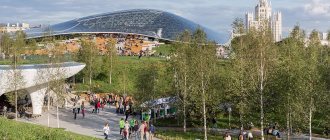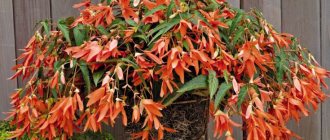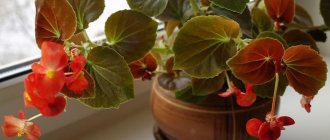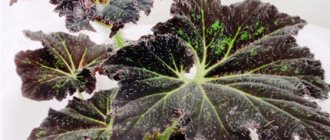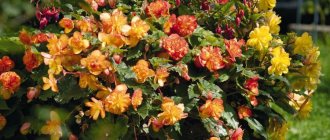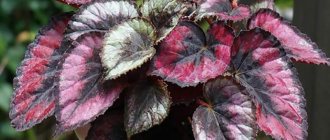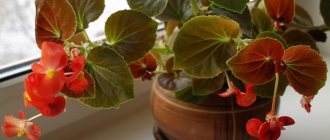Begonias as a species were discovered in the 17th century and gained enormous popularity among amateur gardeners.
Elatior blooms all year round , which is why people like to give it as a gift instead of cut flowers.
A lush head of inflorescences will delight their owner for a long time.
Begonia Elatior is found not only in homes, parks, squares, but also in public places, for example, in hospitals.
It absorbs harmful chemicals and humidifies the air. It is often used in folk medicine due to its antiallergic and antiseptic properties.
Varieties and varieties
Hybrids of begonia elatior are divided into 3 groups: tall - up to 40 cm, medium-sized - up to 30 cm and low-growing plants. The leaves have an asymmetrical shape, resembling the shape of a heart.
Advantages of Elatior:
- Various colors of flowers
- Long flowering (even in winter)
Baladin
A beautiful, abundantly flowering variety. The shades on the inflorescences of one plant can be varied : from white to pink-red. For this feature, they prefer to give Baladin in pots instead of cut flowers. Medium-sized bush with numerous flower stalks.
Borias
This hybrid was bred in England in the 18th century. The most common variety on our windowsills. Belongs to the low-growing group, has a long flowering period, and is unpretentious in care. The inflorescences have double pink flowers with a white edge.
Annabelle
Winter medium-growing variety. The bush is decorated with milky, yellowish double inflorescences. Flowering period from November to July. It is also grown in open ground: in gardens, parks and cottages.
Azothus
Decorative medium-growing course with large pink flowers. Only grown in pots indoors throughout the year.
Bellona
The begonia bush grows up to 40 cm; it is not grown in open ground due to the difficulty of care. Blooms with bright red flowers.
Charisma F1
A low-growing species of begonia. Grown mainly indoors. The colors of the inflorescences range from light pink to orange-red buds. It has 4 varieties that differ in color shades.
Renaissance
A tall plant, the bush reaches 60 cm. It grows on a windowsill; in open ground it is susceptible to diseases. The color of the buds is bright red, the edges of the inflorescences have a wavy edge.
Kyoto
A shrub up to 30 cm tall, distinguished by lush snow-white flowers. Suitable for growing in pots only.
Mix
This is a medium-sized plant. The leaves are serrated, the flowers are arranged in several tiers. Flowers can be completely different - from red to white.
Begonia Elatior: home care
Begonia elatior can hardly be called an unpretentious plant; it is very susceptible to environmental conditions and does not tolerate stressful situations. The plant requires attention; the selection of optimal conditions of maintenance and watering is necessary.
Following a few rules will help you grow a healthy flower.
Lighting
In the warm season, elatior is mainly kept on an eastern or western window. In winter - in the south.
Begonias need a lot of sunlight to bloom abundantly, but direct sunlight causes burns; consider shading part of the glass on the window to maintain a presentable appearance for begonias.
Attention! Direct sunlight causes burns on the leaves.
In the shade, the begonia fades and stops blooming. A lack of light, as well as its excess, affects the size of the inflorescences: the flowers become smaller, and double flowers have fewer petals.
Temperature
Grow plants at room temperature, approximately 21 - 25°C. At low temperatures, begonia stops growing and sheds its buds and leaves.
Begonia is also demanding on air humidity. Buy a steam humidifier or keep the pot on damp expanded clay (moss). It is not recommended to spray directly on a bush with flowers. You can only spray the leaves after sunset to avoid sunburn. As a last resort, place jars of water in close proximity to the plants.
Priming
When planting plants, purchase special loose, light soil “For Begonias”; this mixture easily allows air and water to pass through. Begonia has very delicate and fragile roots, so dense soils are not suitable. When planting a plant in open ground, the mail needs to be prepared by loosening it and removing lumps of earth.
Important! Good drainage is the key to healthy root growth. Stagnation of moisture causes rotting of the root system.
When preparing the soil yourself, you need to take peat, leaf humus and sand in different parts.
Watering and fertilizing
Watering in the warm season is moderate; the soil in the pot should dry out between waterings. In the autumn-winter period, the volume of watering and the frequency of irrigation are halved. For watering, it is used at room temperature, settled.
Avoid moisture retention in the roots, this leads to rotting of the stem. It is better to underwater begonia elatior than to overwater it.
Mineral fertilizers are used for feeding. Excess organic fertilizers will negatively affect the appearance of the plant. Excess nitrogen makes the stems watery, brittle, and increases the risk of rot. Fertilizers are applied from March to September every 2-3 weeks.
In the spring, before the period of active growth begins, the soil in the pot is enriched with long-acting fertilizer.
Transfer
There is no need to replant the flower immediately after purchase; it will need time to adapt. If the begonia blooms, then you should wait until the flowering ends and only then transplant it into a slightly larger pot.
Young plants are replanted annually, adults less often, every 2-3 years.
When replanting, in order not to damage the fragile roots, transshipment is used. The begonia is pulled out of the pot with a lump of earth and, without violating its integrity, is transferred to a new pot. New soil mixture is poured into the voids on the sides.
Trimming and pinching
Pruning is done to simulate the growth of new branches and to maintain appearance. Pruning is carried out with a sharply sharpened knife in autumn or spring. Excess or faded flowers and buds are removed so that they do not take up much energy.
Here's how professionals recommend doing it:
The first pruning is carried out on shoots 7-9 cm long. Before the active growth phase, watering is reduced; when the shoots are 12-14 cm long, pruning is carried out a second time. By removing the side and top shoots, the bush is given the required shape.
Pinching is carried out within the same time frame. The purpose of pinching is to form a voluminous crown.
Reviews
Apparently, flower growers really like Elatior begonia. Spectacular culture. Bright, juicy and odorless (a plus for allergy sufferers). An excellent pot and balcony plant, requiring minimal care, but so decorative that one can make a balcony noticeable. Opinions differ greatly about unpretentiousness: some consider it completely unpretentious, others call it a capricious plant, but do not give up trying to make friends with it.
Particularly successful flower growers manage to prolong the flowering of an old plant for up to two years by pruning the bush in time (and using cuttings to produce new plants). Some note that their plants bloom even in a draft or on a northern window, and require no care at all, while still being covered with flowers. Problems described include: rapid death of the plant, flowers falling off immediately after purchase, problems with propagation by leaves or cuttings.
Begonia Elatior: reproduction
Begonia Elatior is propagated by making a bush, cuttings and seeds. These are the most common methods.
Propagation by seeds
The longest and most difficult method of reproduction. Collecting seeds is very difficult; hybrid seeds do not produce offspring.
Seeds are planted in the soil, which consists of one part peat and sand and two parts earth, in February.
The container is covered with film or transparent glass; the first sprouts appear after 7 days.
The glass is opened slightly for 5 minutes a day and gradually, increasing the ventilation time, is removed.
Advice! To prevent mold, sprouts need to be ventilated daily.
A week later, the sprouts are picked. After two, the flowers are transplanted into pots for continuous growth.
Dividing the bush
In the spring, when the plant is transplanted into another pot, the bush is divided. The procedure must be carried out carefully ; using a sharp knife, the rhizome is divided so that each part of the begonia has a sprout or bud. The sections are sprinkled with charcoal mixed with root.
This is the most painful method of propagation, so after transplantation the plant needs time to adapt and begin active growth.
From the video you will learn how to do it correctly:
Cuttings
The easiest and most common way. In the warm season or during spring pruning, the tops of young shoots with a length of 6 cm are selected. The sections are placed in soil, such as sphagnum, or in water with the addition of coal. Before planting in the soil, the cuttings are kept in a root solution. After one and a half to two months, the cuttings with roots are transplanted into a permanent pot.
Soil selection
Begonias love loose soil with low acidity. The soil should be as saturated with nutrients as possible, so it is better to purchase it in a specialized store. If you prepare the soil manually, sterilize it before planting indoor exotics.
This is necessary to exclude the presence of pathogenic bacteria. It is important that the soil is moderately moist. Begonia categorically does not tolerate waterlogging, this leads to rotting of the roots.
Photo: Before planting begonia, the soil must be saturated with nutrients
Which pot should you choose?
Due to the peculiarities of the root system of Elatior begonia, a large pot is not required. It is desirable that the height is approximately equal to the width of the pot. The material from which the pot is made does not matter. Which flowerpot - made of plastic, ceramics or clay - will fit into the interior, buy that one.
The main criterion should be size . Elatior's root system is small; it takes time to fill the space of the pot with roots, so it is not recommended to immediately plant the sprouts in large pots.
For the first pot, a pot of 8-10 cm in size is suitable. Each subsequent pot during a planned replanting should be 1/3 larger than the previous one. Drainage holes are required.
Features of transplantation
One of the important rules for begonia elatior when caring at home is the correct transplantation of a purchased or donated flower to a permanent place of residence.
The first thing to remember is that this begonia hybrid does not like large pots - the root system develops poorly and does not have time to cover a large amount of soil. Therefore, each subsequent pot should be only a couple of centimeters larger than the previous one.
The soil for replanting should be selected to be loose, retain moisture well, but also dry out quickly if necessary. To make your own soil, you should take the following in equal parts:
- peat land,
- greenhouse and leaf humus,
- add calcined sand
If the plant has spent too long on store shelves and has managed to grow, there is no need to replant it - it will be enough to cut and root the cuttings for subsequent planting.
Diseases and pests
Elatior has sufficient immunity and is rarely susceptible to pests; the main diseases of the plant appear due to improper care.
- Due to insufficient watering and low air humidity, begonia sheds its leaves.
- Mold and rot occur when factors such as cold and high humidity combine. Treatment with fungicides and changing the location will help in the recovery of the plant.
- Lack of light leads to weak leaves and shedding of buds.
Pests brought in from the soil or from a neighboring plant interfere with the growth and development of the bush. The most common diseases that affect begonia are aphids, powdery mildew, whiteflies and spider mites. If affected, treatment with fungicides is necessary. If there are few insects, they are removed using a damp cotton pad.
Important! Inspect your plant periodically for pests. Timely treatment will help preserve the appearance of the bush.
Photo
You will see a photo of the plant:
If you like begonia and are thinking about growing it, then first you should study the varieties and types of this beautiful plant, as well as learn about the features of care and propagation. We will help you with this. Read about the following varieties: Metallic, Royal, Griffith, Hogweed, Imperial. It will also be interesting to get acquainted with decorative deciduous begonia.
Care during the rest period
Proper wintering for all plants is the key to active growth and flowering in the warm season. The main thing you need to pay attention to is the temperature and watering regime.
The temperature must be maintained within 18 - 20°C; if the temperature drops, the begonia will get frostbite and die. Sudden temperature changes are contraindicated. Reduce watering by half and stop spraying.
Additional lighting is not required in winter; daylight hours are sufficient.
How to properly care?
The bush loves moderate watering, the frequency depends on the flowering period - during it it is more abundant, then it is reduced by three times. It should be watered when the soil is almost dry. Under no circumstances should it be sprayed! After all, this leads to the development of various fungal diseases, and can also act like a magnifying glass in the sun, leading to leaf burns.- Prefers a temperature not lower than 18-20 degrees. If it is lower, it dies. It absolutely cannot stand frost. Room temperature (25 degrees) will be acceptable.
- It is important to remove faded flowers in a timely manner. This preserves the splendor and frees up space for new buds.
- Extremely susceptible to stressful situations and deteriorating living conditions.
- During the dormant period, when flowering is finished, special care is required. After the so-called wintering, the cuttings are pruned to 7-8 centimeters. The above-described watering regime and temperature regime are observed. The use of growth stimulants such as Epin and Zircon is also recommended. They will help avoid various problems with the plant.
Other types of begonias also require special care. In order for them to bloom and delight you all year round, you must adhere to certain rules. We talked about this in the following articles:
- Interesting information about flowering begonia.
- Basic rules for caring for ever-flowering begonia at home.
- Magnificent double ever-blooming begonia.
We recommend watching a video about caring for Elatior begonia:

